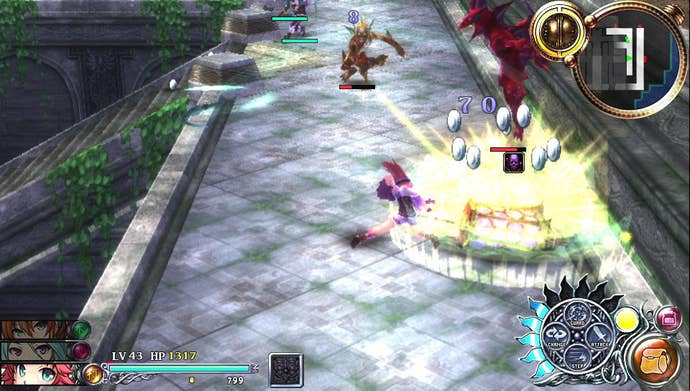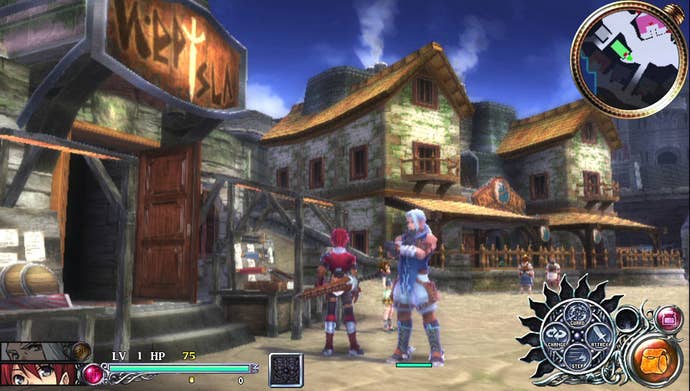Wonderful Memories, Crummy-Looking Postcard: Ys Memories of Celceta Review
Falcom's latest adventure may not be beautiful, but it has a great personality.
This article first appeared on USgamer, a partner publication of VG247. Some content, such as this article, has been migrated to VG247 for posterity after USgamer's closure - but it has not been edited or further vetted by the VG247 team.
To properly appreciate what makes Ys: Memories of Celceta so remarkable, you need to understand a little bit about where it comes from. In the same way that Ys: The Oath in Felghana was a remake of Ys III built on the Ys Seven engine, Celceta likewise recasts Ys IV in the series' modern mold. [Correction: Felghana was built on the Ys VI engine.]
The oddity here comes from the fact that there were two different games published under the name Ys IV, and neither of them were designed by series' creators Falcom. One of those Ys IVs (Mask of the Sun) has been blessed as being more canonical than the other (Dawn of Ys), but neither totally represented Falcom's perspective on the series. So in a sense, Celceta represents the first "real" Ys IV, even though it's not being published under that name.
Since both versions of Ys IV failed to appear in English in an official capacity, I honestly don't know enough about them to be able to point out how much material or influence Celceta draws from either of them, if any. Nor does it actually matter, really, to the enjoyment of the game. It stands perfectly well on its own merits. Nevertheless, knowing the nebulous origins of the game helps paint a clearer picture of why, exactly, it works the way it does -- which is to say, why it spends so much time exploring the past of series protagonist Adol Christin, and why it plays like a mixture of Ys Seven and The Oath in Felghana.

Like the last Ys remake, Celceta appears to be running on the same technology that powered Ys Seven. In this case, though, that's both a curse and a blessing. On the plus side, it means the action is every bit as snappy and smooth as you'd expect; Ys has always prided itself on being the fastest action RPG franchise going, and Celceta upholds that tradition. Like the other PSP-era titles in the series, much of its celerity stems from a heavy emphasis on evasive maneuvers and instant character-switching.
Here, protagonist Adol teams up with a rotating cast of support characters, including a bruiser-type stand-in for his pal Dogi named Duren, an archer who fights much like Ys Seven's Aisha, and others, each of whom deal different types of damage: Slash, pierce, crush, elemental, etc. Enemies in turn bear resistances and suffer weaknesses to each type, so in order to fight most efficiently (and earn the most experience and loot bonuses), you'll need to swap constantly, and instantly, between your party members.
The inactive characters operate under their own AI, which honestly is probably going to be a better warrior than you -- computer-controlled heroes do a remarkable job of dodging enemy attacks. While facing more dangerous foes, though, you'll need to adjust their AI settings to a more defensive style (through a simplified version of the AI grid in Super NES classic Secret of Mana, to which modern-day Ys makes a far more satisfying follow-up than anything Square has managed to come up with in the past 20 years). While I still feel like the lack of multiplayer represents a missed opportunity in modern Ys, it's an understandable design choice; it would muddle up the character-swap mechanics around which combat revolves.
Your protagonists wield a small but effective array of abilities, but none are so important as the ability to null damage by dodging attacks. A perfectly executed dodge (aka "Flash move!") causes time to slow around your character, giving you a chance to score some extra hits or, in the case of enemies with dangerous splash-damage effects, move safely out of range. The timing on this evasive maneuver is far narrower than it was in Ys Seven, so you can't simply spam it and hope for the best; you really need to learn to read your enemies' tells in order to predict their actions. This is especially true for bosses, which tend to be screen-filling monstrosities with tremendous attack power and range.

Unfortunately, that Ys Seven legacy technology makes this slightly more difficult than it ought to. Far be it from me to join the babbling masses complaining about any game with less-than-perfect graphics and sub-60fps frame rates, but Celceta's graphical imperfections can sometimes affect how it plays. The entire game appears to be running at PSP resolution, doubled up for Vita and loaded down with blur and bloom lighting to mask its jagged edges. There's a smeary quality to the entire world, along with a distracting stutteriness in the animations. These herky-jerky movements mostly affect distant monsters at the edge of periphery, but they can sometimes impact the larger enemies as well... that is, the most dangerous foes, the ones whose movements you need to be able to read most effectively.
While these visual quirks can annoy, they mercifully don't detract from the game too much. It's a fundamentally fast-paced action RPG that manages to avoid the flaws that bogged down its predecessors. Its multi-character system creates much more variety than The Oath in Felghana's stripped-down action; the boss battles in particular feel much richer and more strategic than the arcade-style showdowns in Felghana. At the same time, the story manages to be far more compact than Ys Seven's endless jabbering without feeling slight. In a lot of ways, it's the ideal expression of the style Falcom has been refining for nearly a decade.
Celceta also presents an appealing premise to get things running: Adol is sent to map the mysterious forest from which the game takes its name, and much of the quest unfolds through small missions and elective quests. The "sea of trees" actually feels as dangerous as its in-game reputation suggests thanks to tough foes with nasty attacks and the presence of boss-caliber "normal" monsters in nearly every section of the map. I think a big part of what I like about Celceta is how much it reminds me of Etrian Odyssey: You're out mapping a big, mysterious forest until your resources run dry, and every once in a while you bump into a giant monster that will crush you like a bug. The spirit is similar, even if here it's wrapped in the trappings of an action RPG instead of a dungeon crawler.
Whatever Celceta's place in Ys lore, it amounts to a pretty solid adventure by any standard, even if it looks pretty rough around the edges. Falcom continues to refine the series' current direction, and each new Ys is more entertaining than the last.
In Summary
- Visuals: A little painful on the eyes -- Celceta looks like a PSP game upscaled badly with a soft filter smashed over top. But it's so fast-paced you'll probably only notice during the cut scenes.
- Sound: It's Falcom, and that means great music. The partial voice acting is tolerable enough that it probably won't make you angry.
- Interface: Pretty much no-nonsense; thankfully the developers had the good sense to limit back-touch elements to rarely-used functions.
- Lasting Appeal: A fairly meaty adventure, and for the truly dedicated you can tackle it on different difficulty levels.
ConclusionWith plenty of fast-paced (and frequently challenging) action, Ys: Memories of Celceta fills in a gap in the series' history with aplomb. It offers a nice balance between story and combat -- in fact, its biggest shortcoming is strictly technical. A great addition to the Vita's library and the Ys franchise alike.
